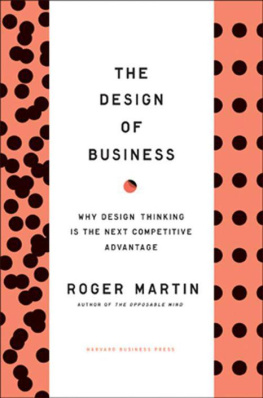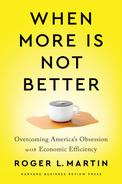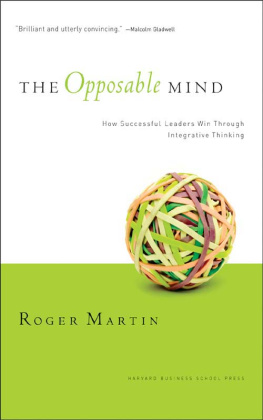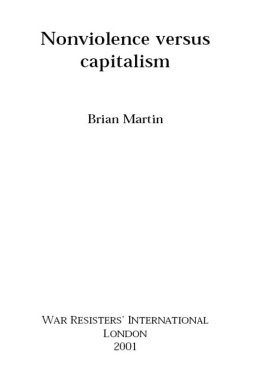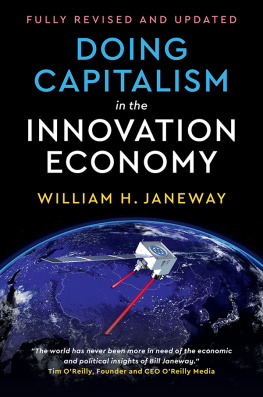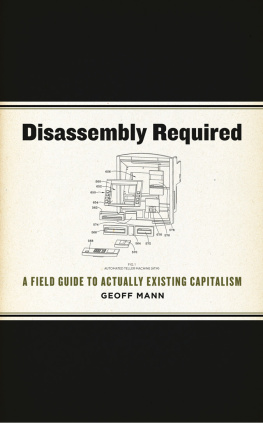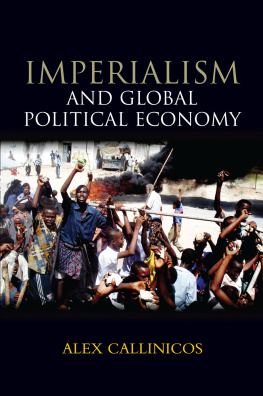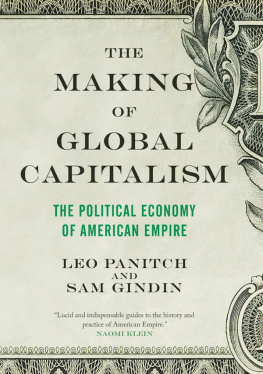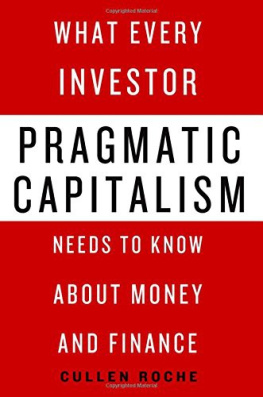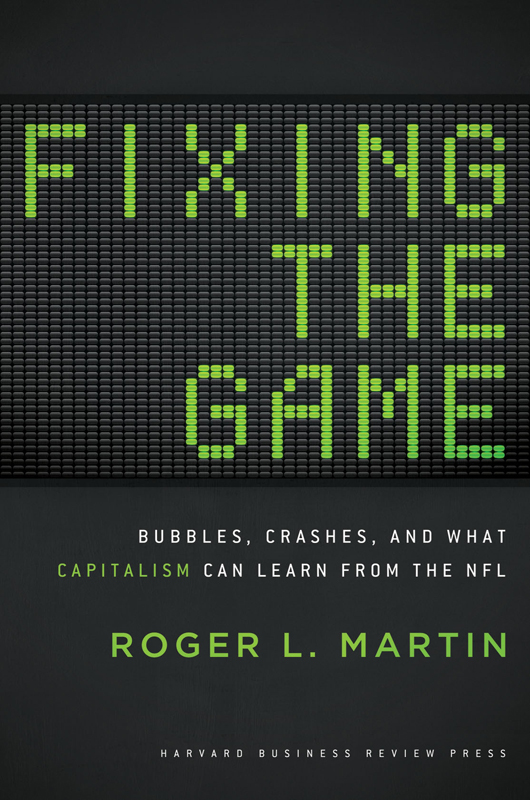
Copyright 2011 Roger Martin
All rights reserved
No part of this publication may be reproduced, stored in or introduced into a retrieval system, or transmitted, in any form, or by any means (electronic, mechanical, photocopying, recording, or otherwise), without the prior permission of the publisher. Requests for permission should be directed to , or mailed to Permissions, Harvard Business School Publishing, 60 Harvard Way, Boston, Massachusetts 02163.
First eBook Edition: May 2011
ISBN: 978-1-4221-7164-6
Roger Martin has written a book that is at once original, insightful, and inspirational. With his tell-it-as-it-is bluntness, he chronicles the failures of modern day capitalism and offers clear and realistic policy recommendations for fixing the game and building a better world for investors. If you enjoy wit and seek wisdom, this is the book for you.
John C. Bogle
Founder and former chief of The Vanguard Group
Weve gone from an economy based on making things to one based on making things up, with Wall Street remodeled as a casino in which the expectations market, reflected in stock prices, has become more important than the real market in which real factories are built, real products are developed and sold, and real dollars show up on the bottom line. Roger Martin offers a riveting account of how the expectations game is beginning to destroy the real game, threatening the future of American capitalism. Through his brilliant analysis of the NFL (which will entrance even those who dont follow the market), he shows us how we can get back to the real game of building for the present and the future. Fixing the Game is a must-read for all who care about business being a positive agent for change in the world. And that should be all of us.
Arianna Huffington
Co-founder and Editor-in-Chief, The Huffington Post
Fixing the Game is an essential book, one that should be read by leaders in the business community and financial regulators worldwide. Martin identifies the insidious trap that can so easily seduce entrepreneurs and CEOsthe temptation to simply trade value rather than create itand provides clear, compelling advice on how to keep focused on the real gameof creating and satisfying customers, running a business legally and ethically, and staying true to a well thought out real world strategy.
Nandan Nilekani
Chairman, Unique Identification Authority of India and former CEO, Infosys Technologies Limited
Fixing the Game artfully links theory and practice, and reminds us that getting both right is important if we are going to fix capitalism. Roger Martin asks provocative questions about what constitutes good management, and forces the reader to consider the ways in which elegant logic or a compelling theory actually undermines commonsense business practice. And along the way he identifies changesin regulation, business, and governance that will realign private incentives with the public good.
Judith Samuelson
Executive Director, Business and Society
Program at the Aspen Institute
Fixing the Game provocatively analyzes the fascinating intersection between seemingly disparate American institutionsthe NFL and Wall Street. Martin brings together the worlds of finance and professional football in a richly compelling story of investors, game changers, and the best ways to fix broken markets. For football fans, business leaders, and policymakers alike, this cautionary tale shows how easy it is to game a sports contest or a market, and how the NFLs structure and policies started by legendary Commissioner Pete Rozelle can be the key to maximizing customer value and healing American capitalism.
Paul Tagliabue
Commissioner of the NFL, 19892006
At last, a gust of fresh air from one business school leader blowing away some of the intellectual smoke supporting compensation and market practices that have come to place American-style capitalism at risk. Roger Martin effectively punctures the illusion that executive stock options, speculative hedge funds, and the single-minded pursuit of stockholder value can build a strong, competitive economy.
Paul Volcker
Former Chairman of the Federal Reserve
To Jennifer Frances Martin...Always
We would accomplish many more things if we did not think of them as impossible.
Vince Lombardi
When a financial bubble bursts, theres a run on scapegoats. With hundreds of billions of dollars in wealth wiped away in short order, its natural to look for someone to blame. So, after each economy-shaking crash, the U.S. Congress goes after the evildoers with determination and vigor. In 1929, it targeted the brokers who fueled a speculative bubble with easy loans and abundant hype. In 2000, the villains were unscrupulous dot-com CEOs, peddlers of counterfeit value that never existed. And in 2008, it was executives at big investment banks, who created inscrutable derivatives from worthless mortgages.
In each case, Congress called the culprits to account at a series of acrimonious hearings, the purpose of which was to sniff out the reasons for the crash and to prevent a recurrence. Each time, once-cocky executives, now suitably humbled, faced the censure of Congress inside committee rooms and crushes of angry reporters outside them. In the aftermath, Congress worked to change regulations to ensure that future players could not engage in the kind of dangerously risky behavior that had led to each crash.
It happened after 1929, after 2000, and after 2008and the aftershocks of the 2008 crash are still being felt. For a clearer view of the pattern, think back to the year 2002. The economy was reeling. The NASDAQ, which sat at 5,132 on March 10, 2000, had lost two-thirds of its value by the middle of 2001, and finally bottomed out at 1,114 in October 200280 percent off its high. The more stable and conservative Dow Jones Average, which had peaked at 11,723 on January 14, 2000, plummeted to 7,702 by July 2002.
As the economy cratered and scores of new-economy companies declared bankruptcy, the search for scapegoats was on. It didnt take long to identify those charlatan senior executives and to vilify them en masse. But a few were singled out for particular blame: No one company symbolized the excesses of the dot-com eraand the disastrous effects of its endlike Enron. And so no executive faced the anger of Congress quite like Ken Lay.
A loquacious and charming character, Lay had been chairman of Enron Corporation for more than a decade and had become a central figure in its undoing. Under Lays leadership, Enron had embraced all the opportunities of the much-hyped paradigm shift to the Internet era, transforming from a boring, old-economy energy company to a new-age, market-making, Web-enabled powerhouse. By 2000, Enron was racking up $101 billion in annual revenue and had a market capitalization of $66 billion. Fortune named it Americas most innovative company six years running, and it was regularly selected as one of the countrys best places to work.
Billions of dollars of shareholder wealth had vanished. Thousands of laid-off employees held now worthless pensions. Yet Lay, his CEO Jeff Skilling, and his CFO Andrew Fastow had made away with hundreds of millions of dollars, thanks to stock options cashed in during the precrash heyday. How could it have happened? How had Enrons board of directors and auditor Arthur Andersen let things go so far wrong? Was it complicity or ineptitude? And, more important, was Enron an isolated case of criminals run amok, or was its failure reflective of much bigger issues? To answer these burning questions, Congress called a multitude of hearings to grill everyone involved.


